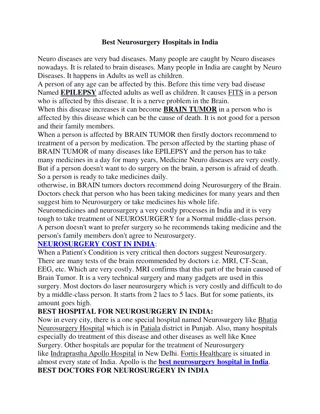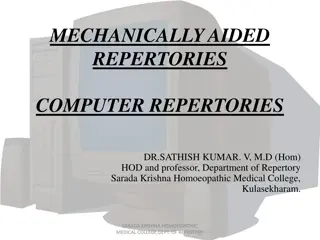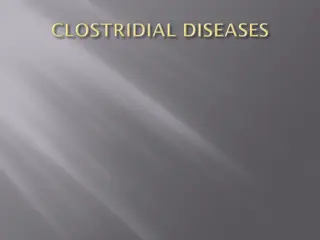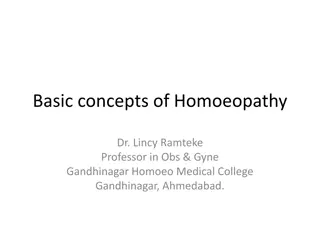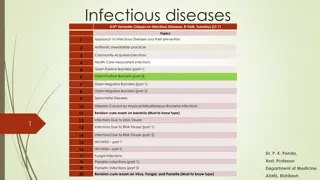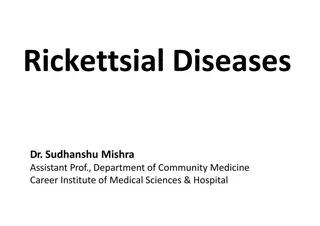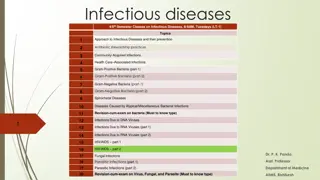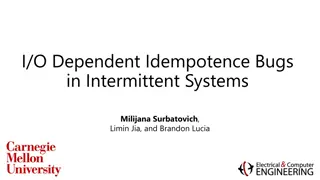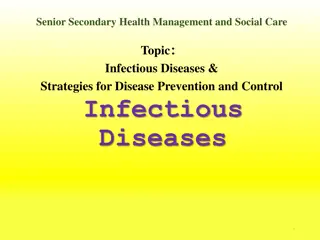Understanding Intermittent Diseases in Homoeopathy
Typical intermittent diseases recur at fixed periods, with patients seeming healthy in between. Learn about classification, treatment, and more in homoeopathy for such diseases.
Uploaded on Apr 19, 2025 | 2 Views
Download Presentation

Please find below an Image/Link to download the presentation.
The content on the website is provided AS IS for your information and personal use only. It may not be sold, licensed, or shared on other websites without obtaining consent from the author.If you encounter any issues during the download, it is possible that the publisher has removed the file from their server.
You are allowed to download the files provided on this website for personal or commercial use, subject to the condition that they are used lawfully. All files are the property of their respective owners.
The content on the website is provided AS IS for your information and personal use only. It may not be sold, licensed, or shared on other websites without obtaining consent from the author.
E N D
Presentation Transcript
Madhav Homoeopathic Medical College & Hospital Department of Organon Of Medicine - Dr. Deepika Department of organon of medicine
Intermittent & Alternating diseases
Intermittent Diseases - The intermittent diseases are those diseases which recur at certain time Periods. -The intermittent diseases may be of two types: 1.Typical intermittent disease 2. Alternating diseases
1. Typical intermittent Diseases (sec.233) - The typical intermittent diseases are those diseases where a morbid state of fixed character returns at a tolerably fixed period, while the patient is apparently in good health, and leaves at an equally fixed period. - so, in the intermittent diseases there is a period when (between the two paroxysm) the patient enjoys apparently good health.
Classification of Typical intermittent diseases:- (A) Afebrile or non-febrile (B) Febrile or intermittent fever
Febrile or intermittent fevers Hahnemann has classified intermittent fevers into following four types:- 1. Intermittent fever prevailing sporadically or epidemically - Sporadic or epidemic intermittent fever. 2. Epidemics of intermittent fever in situation where none are endemic 3. Very pernicious type of intermittent fever attacking individuals not residing in a marshy district. 4. Intermittent fever endemic in a marshy district and tracts of country frequently exposed to inunadatiom
Intermittent fevers prevailing sporadically or epidemically Treatment (A) Selection of medicine - The remedy should be selected from the general from the general class of proved medicine which must- 1.either be able to produce in the healthy body two similar alternating States. 2. Or must correspond homoeopthically to the strongest,best marked and most peculiar alternating state.but the symptoms of the patient's health during the period ofintermission should be the chief guide to the most appropriate homoeopathic remedy
Epidemics intermittent fever where non are endemic
Individual intermittent fever not residing in marshy district Treatment (A) Selection of medicine 1. These cases are to be treated in the beginning like other acute diseases (which like intermittents) by selecting a homoeopathic remedy from the class of proved antipsoric medicine. -this remedy should be continued for some days. 2. But if, inspite of this procedure,the recovery is delayed,it shows that psora is on the point of its development. So antipsoric medicines are to be administered in order to effect a radical cure.
Endemic intermittent fever in marshy district & tracts of country frequently exposed inundation Treatment (A) Selection of medicine 1. in young, healthy man who preserves a faultiess regimen- one or two very small dises of highly potentised solution of cinchona bark, regulated mode or living,speedily free him from the diseases. 2. In persons who takes sufficient exercise- mental and physical :- -They can not be cured of marsh intermittent fever by one or few small doses of cinchona. - such cases show that psora is roused up and antipsoric medicine is necessary to cure them.
- if the psora was not completely devlopmed in them, sometimes it happens that the fever leaves them when these patients move without delay, from a marshy district to a dry mountainous locality. But they will never regain perfect health without antipsoric treatment. - large off-repeated doses cinchona may check the marsh ague but cure can take place only with antipsoric treatment. .
Alternating diseases (sec. 231-232) - Alternating diseases are those diseases in which certain morbid states alternates at uncertain intervals with morbid states of a different kind. -They belongs to the class of chronic diseases which are generally manifestation of developed psora,but seldom complicated with syphilitic miasm. -Examples:- two or three states may alternate with one another.
Treatment of Alternating diseases - when they are of psoric origin, these diseases may be cured by antipsoric medicines. - but when they complicated with syphilitic miasm,they may be cured by alternating antipsoric with antisyphilictics.
Time of administration of medicine in all intermittent diseases 1. Immediately or very soon after the end of the paroxysm ; 2. If the stage of pyrexia is very short or if it is disturbed by some of the after suffering of the previous paroxysm, the medicine should be administered during the decline period of the paroxysm.




